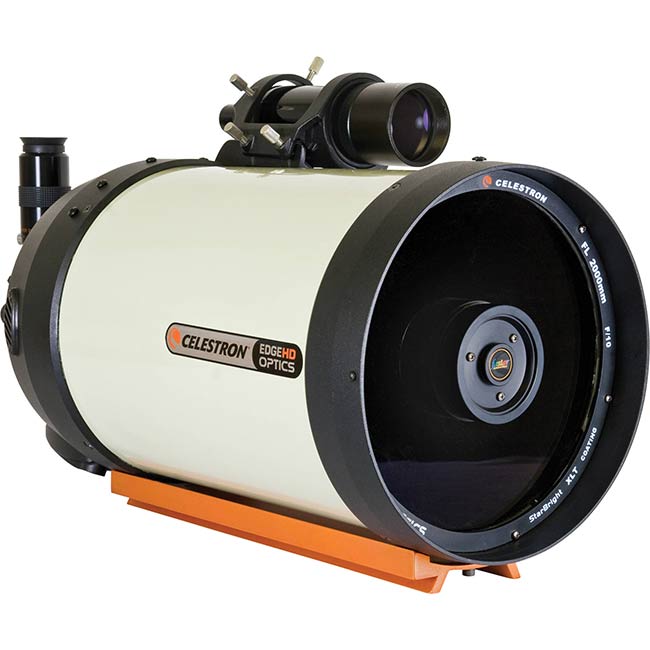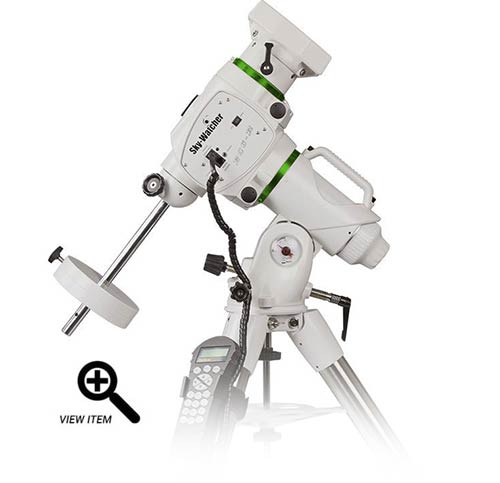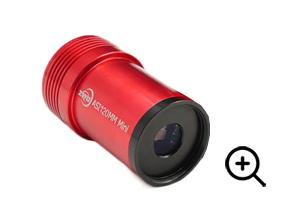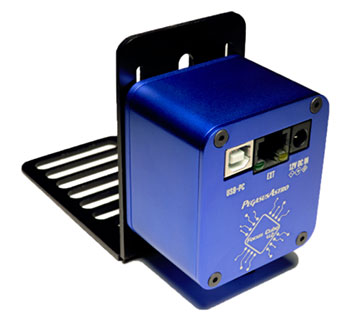Backyard of the Week | July 5, 2021
The AstroBackyard Backyard of the Week highlights astrophotography setups from around the world. A “backyard” can be a balcony, driveway, garden, or wherever else you set up astrophotography equipment at home.
By taking a behind-the-scenes look at the equipment amateur astrophotographers use to take deep-sky images, you can get a better understanding of the process.
This week’s backyard astrophotography equipment profile comes to us from Jason Brown in the United Kingdom.
Location: Yorkshire, United Kingdom
As you can see in the photo above, Jason uses a Schmidt-Cassegrain as his primary imaging telescope. At the base of this 8-inch SCT sits an astro-modified full-frame Canon EOS 6D DSLR camera.
This imaging configuration captures images of deep-sky objects at a focal length of just over 2000mm at F/10 using the native focal length of the telescope. With a Celestron 0.7X reducer threaded in front of the camera, the image field is scaled back to a versatile 1400mm focal length.
Having used the 11-inch version of the Celestron EdgeHD series, I can personally vouch for the impressive astrograph-quality flat focal plane of this telescope’s optics.
Jason Brown
Jason has captured quite the collection of deep-sky objects using his astrophotography setup in the backyard. The following image of the Triangulum Galaxy showcases Jason’s dedication and perseverance to his craft.
Notice the detailed nebulae regions scattered throughout this distant galaxy. Messier 33 has always been a challenging subject for me, and Jason did a great job of preserving the dynamic range and revealing the natural colors on this one.
The Triangulum Galaxy by Jason Brown.
Perhaps the most admirable aspect of Jason’s work is the mix of project types. Wide-field nebulae and small galaxies require a different approach. To capture both object types successfully requires the ability to adapt and evolve your acquisition and processing skills.
The following image of the Tadpoles Nebula in Auriga displays Jason’s artistic flair, opting to give the image a haunting, soft glow. I’ve always recommended that others process an image to “tell the story you want to tell”, and this idea is well highlighted in the approach to this memorable image.
The Tadpole Nebula in Auriga by Jason Brown.
Jason’s Equipment
| Primary Imaging Camera | Canon 6D (modded) |
| Primary Imaging Telescope | Celestron EdgeHD 8 |
| Telescope Mount | Sky-Watcher EQ6-R Pro |
| Filters | IDAS NBX and Optolong L-Pro |
| Guide Scope | William Optics Zenithstar 73 |
| Guide Camera | ZWO ASI120mm |
| Electronic Focuser | Pegasus Astro FocusCube 2 |
| Camera Control Software | APT + PHD2 |
What does Jason love most about his gear?
‘The wide range of different images available to me.’
One of the most attractive features of the Celestron EdgeHD series of SCT’s is the versatility to shoot at three different focal lengths (with additional gear). The EdgeHD 8 can capture images of small galaxies at the native focal length of 2032mm, but can also shoot as wide as 400mm at F/1.9 using the Hyperstar system.
Jason’s Astrophotography Setup in the backyard.
The dedicated Celestron 0.7X reducer for the EdgeHD 8 is a no-brainer for anyone that wants to scale back their field of view and increase the speed of the system to F/7.
I found the reducer to make the most sense for deep-sky projects on the EdgeHD 11, saving the maximum focal length of 2800mm for photographing planets.
Next to the doublet refractor telescope used for autoguiding, I see that Jason has mounted a finder scope to his setup as well.
This is a simple way to aid in the alignment process of the telescope mount (especially on that first star) and gives your eye a chance to see the area of the sky that your telescope is pointed in.
The Camera
The Canon EOS 6D (modified) DSLR camera makes another appearance in the Backyard of the Week. The 6D is a 20.2 MP full-frame DSLR camera capable of collecting fantastic images of objects in space big and small.
This camera has developed quite a reputation in the astrophotography community over the years (released in 2013), and many of these camera bodies are still being used today.
The full-spectrum modification is a common “upgrade” for those that wish to record more light in the hydrogen-alpha bandpass of the spectrum. The 6D is not sold with an astro-modified sensor, but camera bodies with this enhancement can be found in the used astronomy gear websites from time to time.
The Telescope
The Celestron EdgeHD 8” is a catadioptric telescope that combines a Cassegrain reflector’s optical path with a Schmidt corrector plate.
The optical system was designed to deliver sharp and clear distortion-free views with a focal plane more than three times flatter than a standard Schmidt-Cassegrain telescope.
The large focal length of the EdgeHD 8 provides you with the versatility to shoot smaller deep-sky objects with great detail.
Celestron EdgeHD 8″
- Type: Schmidt-Cassegrain
- Diameter: 203 mm
- Focal Length: 2032 mm
- Focal Ratio: f/10
- Weight: 14 lbs (6.3 kg)
The Telescope Mount
The Sky-Watcher EQ6-R Pro seems to be the perfect equatorial telescope mount for a large audience of deep-sky astrophotography enthusiasts. It is so popular, in fact, that getting your hands on one these days may mean waiting several months.
Those who are lucky enough to have an EQ6-R sitting in their backyard are rewarded with reliable tracking performance night after night.
This intermediate-level mount can handle a wide variety of optical instruments, and it’s nice to see that a Celestron EdgeHD 8 is a great fit for this mount.
The Sky-Watcher EQ6-R Pro Mount.
The Filters
Jason listed two filters in his equipment profile, the IDAS NBX filter, and the Optolong L-Pro filter. This is an ideal scenario for those that wish to collect dynamic emission nebulae, as well as broadband targets such as galaxies and reflection nebulae.
The IDAS NBX filter was designed to enhance the contrast of Ha and OIII nebulae regions. It is a dual bandpass narrowband filter that allows one-shot-color dedicated astronomy cameras and DSLRs to ignore much of the unwanted artificial light of a light-polluted sky.
The IDAS NBX (Nebula Booster) Filter.
The Optolong L-Pro Filter is best used when collecting deep-sky objects that emit light in the broad spectrum, such as galaxies. The Optolong L-Pro filter does an admirable job of reducing the unwanted glow from the city while allowing important wavelengths of true-color light to reach the camera sensor.
The Guide Scope
Jason uses an incredible imaging telescope to autoguide his imaging sessions in the backyard. The William Optics Zenithstar 73 allows him to lock on to a star at a focal length of 430mm, and make subtle improvements to the telescope mounts’ tracking accuracy.
This is a fantastic astrophotography telescope in its own right, which is a great option to consider when piggybacked on top of Jason’s primary imaging telescope.
The William Optics Zenithstar 73
The Guide Camera
At this point, I’ll just assume that all future Backyard of the Week recipients are using a ZWO ASI120MM Guide Camera. If I were to make a chart of the most popular items found in setups featured for BOTW, this camera would hold the number one spot (with the EQ6-R Pro right behind it).
If you need an affordable guide camera (that doubles as a planetary imager), do yourself a favor and pick up a ZWO ASI120MM Mini (I use one, myself).
ZWO ASI120MM Mini.
Accessories
Jason uses some interesting accessories to run his deep-sky astrophotography rig. The Baader UFC filter drawer allows him to quickly swap 48mm filters depending on the type of project he’s shooting.
A filter drawer is an incredibly handy option when shooting with a one-shot-color camera without a filter wheel. This accessory allows you easily change filters without having to worry about disrupting the exact spacing of your imaging sensor.
Baader UFC filter drawer (48mm)
The Pegasus Astro FocusCube 2 is another noteworthy upgrade to Jason’s system. An electronic auto focuser is essential if you want to make subtle focus adjustments to your telescope hands-free and remotely.
You can also set the focuser to automatically adjust the focus of your camera and telescope throughout the night as conditions and temperatures change.
The Pegasus Astro FocusCube 2.
Thank you for sharing your backyard astrophotography set up with us, Jason! You can view Jason’s astrophotography on Instagram.
Be sure to fill out the form to submit your backyard for a chance to be featured, and don’t forget to include your Instagram handle to help grow your following.
View the Backyard of the Week Archives











